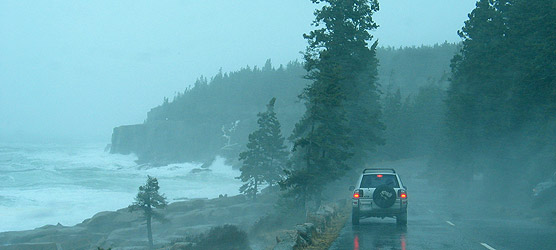 |
 | |
  | |
|
|
|
|
Acadia National Park
Weather
|
|
|
|
|
|
 |
|
Acadia's weather is largely a product of latitude and marine influences. On a daily and annual basis, Mount Desert Island temperatures are more moderate than those of inland Maine. The Maine coastal climate has been ranked second only to the Pacific Northwest in annual precipitation. This moisture occurs in every form at Acadia. Ice storms are regular in winter and early spring, and rain is frequent in every month. Fog is common during June, July, and August.
.
|

|
| NPS/Sheridan Steele |
| Storms called nor'easters can bring pounding surf and heavy rains to Acadia during the winter and early spring. |
|
|
Average Temperatures and Precipitation
|
Jan |
Feb |
Mar |
Apr |
May |
June |
July |
Aug |
Sept |
Oct |
Nov |
Dec |
| Average Day Temperature in Fahrenheit |
32 |
33 |
41 |
52 |
64 |
72 |
77 |
76 |
68 |
58 |
48 |
37 |
| Average night temperature in Fahrenheit |
14 |
15 |
25 |
33 |
42 |
51 |
57 |
56 |
49 |
41 |
33 |
19 |
| Average rainfall in inches |
4 |
4 |
4 |
4 |
4 |
3 |
3 |
3 |
4 |
4 |
6 |
5 |
| Average snowfall in inches |
16 |
17 |
11 |
3 |
Trace |
0 |
0 |
0 |
0 |
Trace |
2 |
12 |
|
|
Average annual rainfall: 53 inches (average from 1982-2005)
Average annual snowfall: 61 inches (average from 1940-1985)
Spring can be foggy with temperatures ranging between 30 and 70 degrees F. Wear light-colored clothing, long sleeve shirts, and long pants for protection. Annual rainfall is 48 inches.
Summer daytime temperatures range from 45 to 90 degrees F. Evenings are cooler. Dressing in layers is advisable for any boating or hiking activities. Ocean water temperatures range from 50 to 60 degrees F. Lake water temperatures range from 55 to 70 degrees F.
Fall temperatures can range from low 70s during the day to freezing during the night. Come prepared for all types of weather, from sun to fog, from downpours to flurries. Fall foliage often peaks during the first few weeks in October; the peak time is generally mid-October. Weather conditions over the summer, such as drought, may alter the time that the leaves peak. Visit the park's leaf-peeping page or the state of Maine's fall foliage website for more information.
In the winter, due to Acadia's coastal location, snow and weather conditions change rapidly. Temperatures vary from mid-30s to below zero. The park averages 61 inches of snow annually. For the latest in weather information, call the local weather phone line at 207-667-8910 or call the park at 207-288-3338.
|
|
Weather Links
Real-Time Air Quality Web Cams and Weather Data (includes ozone levels, temperature, wind speed and direction, precipitation, and more)
Ozone Information
Air Quality Hotline - 800-223-1196
|
|  |  |

|
 |
|
|
|
|
|
 |
|
Did You Know?
Cadillac Mountain in Acadia National Park is the tallest mountain along the eastern coast of the United States. During certain times of the year, it is the first place in the U.S. to see sunrise.
|
|
|
|
Last Updated: March 17, 2009 at 08:25 EST |






